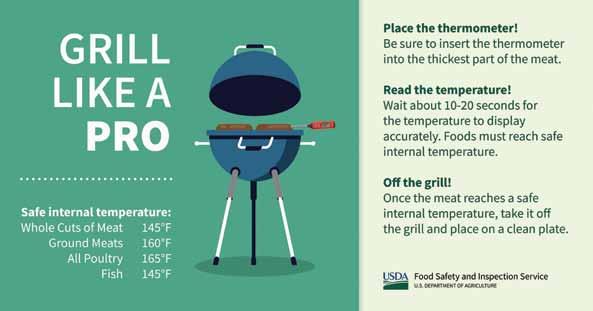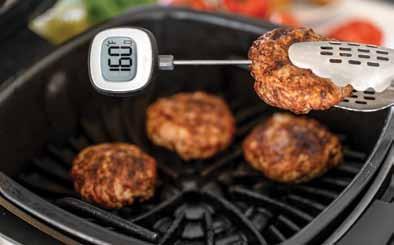
2 minute read
Keep outdoor food preparation safe and fresh during summer

By elizabeth Bobenhausen poultry times staff ebobenhausen@poultrytimes.com
Advertisement
GAINESVILLE, Ga. — Summer is officially upon us, and the warmer months can be very hazardous to particular foods.
“USDA reminds summer travelers not to let your outdoor meal become a feast for bacteria,” Dr. Emilio Esteban, USDA under secretary for food safety, said. “Bacteria grows faster during the summer months because it’s warmer and more humid. Pack perishable foods safely with a cold source and wash your hands thoroughly while preparing food.”
The U.S. Food and Drug Administration defines salmonella as “a group of bacteria that can cause gastrointestinal illness and fever called salmonellosis.” The FDA adds that salmonella can be spread “by food handlers who do not wash their hands and/or the surfaces and tools they use between food preparation steps.”
The USDA’s Food Safety and Inspection Service says, “Leaving food out too long at room temperature can cause bacteria (such as Staphylococcus aureus, Salmonella Enteritidis, Escherichia coli O157:H7, and Campylobacter) to grow to dangerous levels that can cause illness.”
Know the basics
The USDA gives four basic guidelines to remember. The agency says to avoid the “danger zone,” as well as safety on the road, camping/backpacking and washing your hands.
• The ‘Danger Zone’
Food that sits in temperatures amid 40 degrees F and 140 degrees F is deemed to be in the danger zone. The food does not have long before it will begin to spoil and could cause illnesses. It is important to put spoilable food in the refrigerator within two hours. If it is more than 90 degrees F outside, put perishable food in the refrigerator within one hour. Cold foods must be stored in a cooler at 40 degrees F or lower. Hot foods are to be on the grill or warmer plates at 140 degrees F. Leftovers are to be split up in small quantities and put in small containers. The leftovers must be put in a cooler below 40 degrees F.
• Safety on the road
While traveling it is important to make sure the cooler is stocked to hold any food that may spoil. Keep food and drinks in separate coolers. The cooler holding the drinks will be opened more often therefore the temperature in the cooler will change. The cooler holding the food must be put in the shade once outside.
Keep the cooler full. There will be more protection for the food. If the cooler is half full, fill it with ice to maintain the cool temperature.
• Camping and backpacking
If someone is going camping for more than one day, bring stable shelf products in the instance the products run out.
According to the USDA, some products to bring camping include:
1. Pre-packaged, shelf-stable meals
2. Peanut butter in plastic jars
3. Concentrated juice boxes
4. Canned tuna, ham, chicken and beef
5. Dried noodles and soups
6. Beef jerky and other shelfstable meats
7. Dehydrated foods
8. Whole or dried fruits
9. Nuts
10. Powdered milk and fruit drinks
• Washing your hands
To maintain safety, a person should always be mindful of washing their hands during food preparation. When using water and soap, a person must be sure to wash their hands for 20 seconds. If there is not any running water, use hand sanitizer or a wet alcohol wipe for hand cleaning.
The hand sanitizer or wet alcohol wipes must contain at least 60 percent alcohol. A person must never wash their hands in a river or stream because of the potential for the water to not be clean.
Cooking
According to FSIS, raw meat and poultry should be cooked to a minimum of 165 degrees F. However, roasting meat and poultry is a different process. When roasting meat and poultry in the oven, it must be cooked at 325 degrees F. If a person wants to keep the meat warm, they must keep meat at 140 degrees F or above. Food must be reheated to an internal temperature of 165 degrees F. Be sure to cover the food and rotate it while in a microwave oven.
(Continued on page 21)









